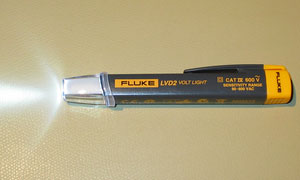Difference between revisions of "Neon screwdriver"
(m) |
(→Alternatives: fix) |
||
| Line 36: | Line 36: | ||
==Alternatives== | ==Alternatives== | ||
| − | + | One alternative is a non-contact volt stick: | |
[[image:VoltStick-2.jpg]] | [[image:VoltStick-2.jpg]] | ||
| − | These can | + | These remove the direct shock risk but suffer false negatives and false positives, so can fail to indicate a live circuit. They are useful as they're fast, since no conducor need be bared to take a reading. But relying on them before touching a potentially live wire is not recommended, and not legal in a work setting. |
| − | |||
| − | |||
| + | A [[multimeter]] or voltmeter can will do far more than a neon screwdriver, and do so with more reliable results. Multimeters have their own safety issues, but they are much less and more under the control of the end user, so can be minimised with care. | ||
==See Also== | ==See Also== | ||
Latest revision as of 23:19, 3 December 2017
Neon screwdrivers are fairly crude tools that combine the functions of a small terminal screwdriver with a mains voltage detector. However they have a number of safety problems, and the majority view on uk.d-i-y is that the voltage detection capability is best not used at all.
How they work
Mains power flows down the screw driving tip to the resistor and neon in the handle. When you touch the brass cap, the body's natural capacitance allows enough power to flow through the screwdriver and the user to cause the neon to light.
This small current is entirely harmless, there is no electric shock under normal circumstances.
The Problems
Direct shock
Water or condensation on the resistor can result in the tool shocking the user, maybe causing a fall from a ladder. Hence never hold one of these screwdrivers in your mouth, eg when working with both hands.
Certain tool faults such as resistor a failure can create similar risks.
False negative
The lighting of the neon is sometimes too dim to see, especially in daylight. The result is shock from touching a live wire, and this is probably the most common failure mode.
Not being connected to or near earth, insulated from ground, can reduce current flow further, making the neon even dimmer. The body being capacitively coupled to some other nearby live conductor, can prevent the light lighting at all, even when the screw driver tip is touching a live wire or contact.
False Positive
A user capacitively connected to a live supply will light a neon screwdriver touched to a non-live wire. Its quite easy to be capacitively coupled in this way without noticing. Holding an inspection light, standing on a cable, even leaning on a wall in some cases, and so on. Also touching a "floating" conductor (i.e. an unconnected wire that is routed in close proximity to other live wires) may also yield a false positive test.
Minimising risk / safe use
If you must use one of these devices, then adopt a sound "proven dead" approach to testing. Before making a test, test the screwdriver on a known live conductor and ensure it lights up. Next test the unknown conductor, and ensure it does not light, Finally test again on a known live conductor.
Avoid putting the tool anywhere that may expose it to allow water or condensation, such as a shed, outdoors, in one's mouth etc.
Legality
There is some question as to whether these tools, are legal to use in the workplace, since they don't possess a number of the attributes deemed necessary in electrical test gear by the health and safety executive. See the document GS38 Electrical Test Equipment for Electricians (PDF) - in particular section 9.
Further discussion
Alternatives
One alternative is a non-contact volt stick:
These remove the direct shock risk but suffer false negatives and false positives, so can fail to indicate a live circuit. They are useful as they're fast, since no conducor need be bared to take a reading. But relying on them before touching a potentially live wire is not recommended, and not legal in a work setting.
A multimeter or voltmeter can will do far more than a neon screwdriver, and do so with more reliable results. Multimeters have their own safety issues, but they are much less and more under the control of the end user, so can be minimised with care.
